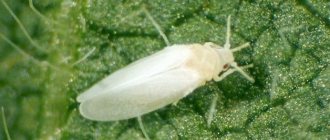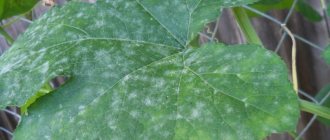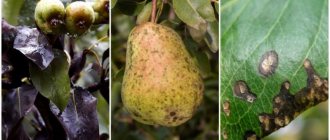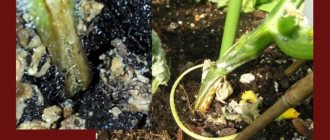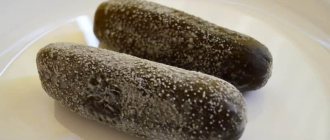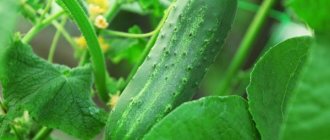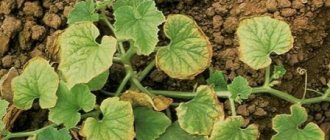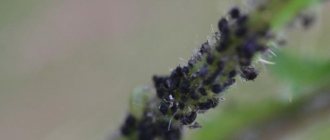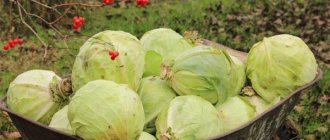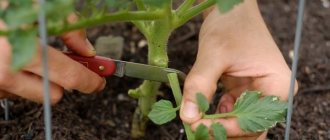Voracious white midges on the leaves of planted cucumbers will destroy most of the crop if measures are not taken. It is not difficult to determine what kind of dangerous pest has settled on the site. The insect has two pairs of wings, the surface of which is covered with a pale yellow coating. The pest's favorite habitat is the inside of the leaf. The reasons for the appearance of the insect are due to the mistakes of the gardener who does not monitor the conditions in which the seedlings are kept. Effective methods of combating it are related to the elimination of such shortcomings.
What factors provoke the appearance of a pest?
High temperature and high humidity levels are two negative factors that adversely affect crispy vegetables. It is a mistake to think that an insect lives only in greenhouse conditions, where a closed ecosystem exists. In open ground, white midges can make themselves felt. The adult individual prefers the juice of the plant - its favorite food. The more actively the pest satisfies hunger, the faster the bush dies.
You may be interested in:
Fighting spider mites in a greenhouse on cucumbers If you are interested in the question of how to get rid of spider mites on cucumbers in a greenhouse, you should familiarize yourself with folk...Read more...
The second problem caused by the activity of the parasite is the secretion or dew it secretes. A pathogenic fungus multiplies in it. After 24-30 hours, the cucumber seedlings become sick. Productivity decreases. The third problem is that midges need leaves to lay eggs. They are located along the inside. Less often, the masonry is noticeable on the stem or at the base.
On a note!
Not only heat and high humidity levels can provoke the appearance of a parasite in an area. White-winged midge eggs can be introduced if you take untested planting material. The source of problems will be the neighbor's garden, the owner of which does not engage in prevention.
Why does the white midge appear?
White midges are a common sight on cucumbers. These pests attack the plant during the growing season. The tiny insect, just a couple of mm in size, has 4 wings and resembles a moth. The midge lives only 2 weeks, but during this period one female manages to lay more than 150 eggs. Its larvae are able to reach the root system of the plant, penetrating the soil, and destroy the tops of the vegetable. The midge lives in small groups. Most often it settles on cucumbers growing in a greenhouse. Such conditions are most suitable for this insect, which loves warmth and high humidity.
Signs of winged pest activity
Early detection of midges minimizes possible harm to seedlings. The first and obvious symptom is white dots on the leaf blade. If only eggs have settled on the bush, you may notice blurry white spots. Other symptoms:
- the appearance of characteristic powdery mildew secreted by insects on the edges of leaves;
- a sharp decrease in cucumber mass;
- leaves curl;
- signs of chlorosis disease appear, the carrier of which is midges;
- buds dry out quickly;
- ovaries with buds fall off.
You should be wary of a swarm of insects or several individuals. The pest is voracious. For him, leaves are a delicacy that he is ready to consume in huge quantities. Within 2-4 days from the beginning of the active phase, the leaf blades are covered with a sticky mass. You can determine it by touch. Once the midge becomes an adult, its body is covered with a sticky substance. It protects the insect from negative environmental factors. It is destructive for seedlings. Traces of burns are visible on the leaf plates.
White midge or greenhouse whitefly
Whitefly
Another dangerous pest is the greenhouse whitefly. This is a small insect with white wings and a body covered with a white waxy coating.
The whitefly settles on the back of the leaves.
Despite its small size, this pest quickly destroys crops.
Just like aphids, they feed on plant sap.
In addition to this, the whitefly secretes a substance containing sooty fungus. The plant becomes sick, the leaves and lashes quickly darken and die.
It is easier to protect yourself from an insect than to remove it. In order to avoid the appearance of the pest in cucumbers, before planting cucumbers, it is necessary to stretch gauze over the greenhouse windows. The doorway should also be covered with fabric.
As in the previous case, weeds can become a source of unwanted guests. They need to be uprooted and thrown away. Special pest traps work well. Cucumbers can be treated with the two percent Actofit preparation. Three sprays per season are enough.
Chemical control agents
The use of specialized “chemistry” is permitted in open ground and in greenhouses in limited quantities. Violating the recommended proportions indicated on the packaging will cause more harm than midges. The drug "Iskra Bio" is developed on the basis of components that have minimal effect on the cucumber bush:
- it is allowed to process seedlings at the fruiting stage;
- safe for farm animals;
- safe for humans, but Iskra Bio can only be used with protective gloves;
- 72 hours after treatment, the crop does not contain any components of the drug;
- Application is carried out during the day at a temperature of + 25 C + 30 C.
Dissolve 40 ml of Iskra Bio in 5 liters of clean warm water. Treatment is carried out 2 times a week for 1 month. If the symptoms have disappeared, then the application of the biologically active substance is continued for another 3-4 days. Solutions based on the drug "Aktara" are prepared by owners of large plots or commercial farms.
4 g of substance are dissolved in 10 liters of water. Spraying is carried out once every 5 days for 3 weeks. Another means of combat is Mospilan. A broad-spectrum drug is used at the initial stage of pest activity. Take 1 substance per 2 liters of water. Consumption rate – 200 ml for every 1 m².
You may be interested in:
Aphids on cucumbers: causes of appearance and methods of control Aphids are a dangerous harmful insect that lives in symbiosis with ants.
The presence of the latter on the site is one of the main...Read more...
Why do midges appear?
On seedlings you can notice not only white, but also black midges. Despite the fact that these insects are outdoor pests, they easily enter the house through the window and take root well in pots with sprouts.
The tiny black sciarid midge is dangerous for seedlings. It itself does not harm plants, but its larvae quickly multiply in damp soil and gnaw the roots of sprouts. This causes the seedlings to quickly die.
The main reason for the appearance of parasites is excessive watering, especially in the cool season. When the soil is constantly moist and does not have time to dry out, a comfortable atmosphere is created for the development of larvae.
Pests are often found in the soil that gardeners buy in the store. Small larvae are difficult to notice until they begin to actively spread, and this happens when the seedlings are already sufficiently grown and strong.
To preserve the plant and get rid of insects for a long time, there are many simple and effective ways.
Folk methods of struggle
Botanists urge not to rush to conclusions. On the one hand, traditional methods of pest control have no side effects. Repeated treatments will not lead to the accumulation of toxins in the fruits. On the other hand, the effectiveness of traditional methods leaves much to be desired. At the initial stage of infection, there is a high chance of ridding the leaves of midges.
Important!
If whitefly activity is noticeable for more than 5-7 days, it is worth using “chemistry”.
The classic folk “fighter” against midges is red pepper, on the basis of which a tincture is prepared. Take 200 g of tobacco dust and 10 liters of water. Both components are mixed. Further procedure:
- add 30 g capsicum;
- give 24 hours for the mixture to infuse;
- add 1 tablespoon of laundry soap;
- add 3 tablespoons of tree resin;
- to stir thoroughly;
- Spraying is carried out once every 7 days for 3 weeks.
The second recommendation on how to deal with the pest yourself involves the use of traps. Take a piece of light-colored cardboard, on top of which decorative non-drying glue is applied. If you don't have it, you can use castor oil. Similar traps are placed among cucumber plantings. In the morning and evening, each bush is gently shaken. The midges fly up and land on the surface of the cardboard. Garlic solution is a more radical remedy, according to folk recipes:
- 2 cloves of garlic;
- grind them to a pulp;
- add garlic to a bucket of water (1 l);
- the solution is left in a dark place for a day;
- after 24 hours, the mixture is filtered;
- spraying of plantings is carried out 3 times during the week;
- after a 1-week break, spraying is repeated.
Folk remedies cannot be perceived as a panacea. If within 5-6 days of use the number of midges has not decreased, you need to switch to “chemistry”.
On a note!
You cannot use the same folk remedies more than 4 times during the season. Midges develop immunity. Further processing becomes ineffective.
Fighting white midges
It is very difficult to get rid of whiteflies, no matter what garden crop this insect settles on. A whole range of measures is required here, alternating biological preparations, manual assembly and chemical treatment.
Prevention
Last but not least is prevention:
- Destruction of all organic residues in the greenhouse.
- Spring and autumn digging of the soil with the incorporation of green manure.
- Pre-planting seed treatment with a weak solution of potassium permanganate.
- Treating the greenhouse with a smoke bomb before planting seedlings.
The greenhouse must be disinfected regardless of whether you have had pests or not.
- Timely weeding of holes and row spacing.
- Increasing plant immunity with stimulating fertilizing.
- Timely stepsoning. Bushes should be well ventilated.
If there is a small concentration of flying moths, sticky trap tapes (fly tapes) should be hung. If clutches are found, remove them from the plant (along with the leaf or wash with soap and water).
You can make a sticky trap yourself from a sheet of yellow paper and a sticky mixture.
Enemies
The white midge has many biological enemies: ladybugs, encarsias, wasps, macrolophus bugs.
Bioinsecticides that require treatment at least 4 times per season have good performance: Nemabakt, Bicol, Aversiktin-S, Bitoxibacillin, Avertin-N .
It is these preparations that are recommended for use in greenhouses, as they begin to work at temperatures from +18–20 °C and humidity 60–80%. When preparing solutions for treatments, you should strictly follow the instructions.
Treatments for severe infestation
In case of severe damage to plants by whitefly, chemical treatments are recommended: Aktara, Aktellik, Iskra, Confidor and other remedies for sap-sucking pests in the greenhouse.
Chemicals gradually become addictive to pests, so they must be alternated.
To combat white midges, all folk remedies and chemicals that are effective in aphid treatments are suitable, but they are effective only against adult butterflies. Covered with a waxy coating, the larvae on the plant are weakly susceptible to external influences and treatments. Therefore, the procedures are repeated systematically until the hatching individuals are completely eradicated.
Preventive actions
White midge pests appear on cucumbers under conditions of a consistently unfavorable temperature background for cucumbers. It is enough to install a thermometer in the greenhouse to not give parasites a chance. The nighttime temperature background is kept at + 17 C + 20 C, and the daytime temperature is not higher than + 28 C. The second detail is the arrangement of ventilation. In a greenhouse, the system ensures a uniform flow of air, but not a draft. The third detail is regular preventive disinfection of the soil. The drugs "Karbofos" or "Decis" are used once every 4 weeks, according to the instructions. Other recommendations:
- Punctuality – sowing deadlines must be observed. It all depends on the characteristics of the selected cucumber variety.
- Quality - seed material is purchased in the store. You cannot plant it without first disinfecting it in a solution of potassium permanganate.
- Humidity level - before each watering, check the water content in the soil. If it is wet, then you should wait. Too much water, as well as not enough water, will weaken the plant.
- Clean – Weeds, fallen leaves and other waste are removed immediately. You cannot leave biological residues on the garden bed - a breeding ground for the pest.
The harvest ends with a general cleaning of the greenhouse. If cucumbers were grown in open ground, then dig up the soil. The last recommendation for what a gardener should do is to till the soil. Use copper or iron sulfate.
The whitefly midge is a pest that eats the leaves of cucumber seedlings. The danger is posed by adults and young animals. The first symptoms are noticeable immediately after infection. The characteristic white spots and dots on the leaves should alert the gardener. At the initial stage of infection, you can get by with folk remedies. From the moment the insect’s active phase begins, “chemistry” comes into play.
Mining flies
Leaf miners are also often called midges. The insects got their name from their feeding habits. The length of adult individuals does not exceed 2 mm. The color is variable and depends on the species. The female pierces the foliage with her ovipositor and lays eggs. After a few days, larvae emerge from them and gnaw through white passages called mines. After the food resource is exhausted, the young individual moves to the next leaf.
The female lives about 7 days. During this time, she manages to lay up to 400 eggs.
Insect activity begins in May and June. In case of serious infestations, plant growth deteriorates and leaves die off. How to deal with leafminer on cucumbers:
- colorful sticky traps are used to prevent the invasion of dangerous parasites;
- damaged leaves must be removed;
- surviving plants are treated twice with insecticides; Before flowering, you can apply Aktar, during the fruiting period - Vertimek.
Only regular inspection of seedlings, timely care and identification of pests will help preserve the cucumber crop.
Parasite recognition
If midges appear on the stems, this is the very first sign of the development of the disease. The small butterfly is called a whitefly. It is characterized by one feature - gathering in small groups under the leaves. Midge larvae concentrate in the same place. Every day there are more and more parasites on cucumbers.
In parallel with the disease, chlorosis develops. It is a mosaic lesion of yellow leaves. Sooty fungus is often observed. Black spots indicate its presence. The leaves of cucumbers, which are parasitized by the midge pest, gradually turn yellow and wither, and the ovaries fall off.
In order to timely identify the whitefly and begin to fight it, you need to carefully monitor the seedlings. Butterflies tend to reproduce quickly. Thus, midges move to other plants. A farmer could lose his entire crop because of a small insect.
